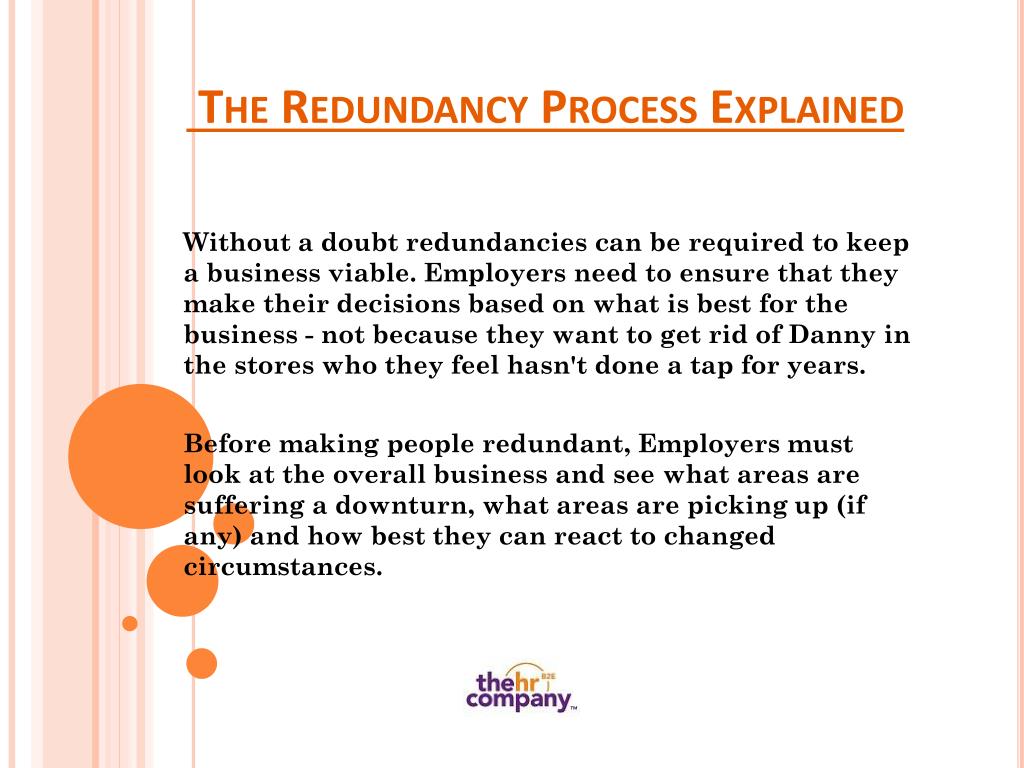Small Business Closing Employee Rights UK: What You Required to Understand About Redundancy
Small Business Closing Employee Rights UK: What You Required to Understand About Redundancy
Blog Article
Exploring the Interaction In Between Firm Redundancy and Organizational Flexibility for Future Growth
In the vibrant landscape of today's business world, the detailed relationship between firm redundancy and business versatility emerges as a vital factor for continual development and success. Companies frequently deal with the obstacle of striking a fragile balance between preserving a level of redundancy to alleviate threats and cultivating versatility to respond quickly to the ever-evolving market needs.
Importance of Company Redundancy
Company redundancy is an important element that improves business strength and reduces functional risks. By incorporating redundancy actions within the business structure, business can better withstand unanticipated disruptions and changes in business setting. Redundancy functions as a tactical buffer, enabling companies to adapt and react efficiently to unexpected difficulties without compromising important operations.
One key element of the value of company redundancy is its function in guaranteeing continuity throughout times of dilemma. When faced with sudden modifications or emergency situations, redundant systems, sources, or workers can tip in to keep critical functions and prevent widespread disturbances. This connection not only safeguards the firm's track record and customer count on however likewise reduces monetary losses and operational downtime.

Strategies for Business Flexibility

Developing adaptable business frameworks that permit for quick modifications to market characteristics and consumer demands is vital for staying competitive in a rapidly developing environment. By proactively determining prospective disruptions and chances, organizations can proactively adapt and flourish in an ever-changing service landscape.
Harmonizing Redundancy and Versatility
Accomplishing a harmonious balance in between functional redundancy and organizational flexibility is extremely important in navigating the intricacies of a vibrant company atmosphere. Striking the best equilibrium in between redundancy and flexibility is a fragile procedure that requires a deep understanding of the company's objectives, market characteristics, and risk resistance.
To achieve this balance, companies require to carry out regular evaluations of their operations to recognize locations where redundancy is required for threat reduction and where adaptability can drive advancement and growth. Implementing versatile structures, promoting a culture of constant knowing and renovation, and encouraging open interaction throughout all levels of the company are essential methods to balance redundancy and versatility successfully. By straightening these two important elements, companies can position themselves for lasting growth and success in an ever-changing company landscape.
Situation Studies on Adjustment Success
In checking out instances of successful organizational adjustment, it becomes noticeable that the interplay in between functional redundancy and flexibility is a specifying factor in forming resistant services. One engaging situation research is that of Netflix. Initially a DVD rental service, Netflix showed impressive adaptability by transitioning into a streaming system when digitalization interrupted the market. By tactically investing in technology and material creation, Netflix not just endured however grew in a quickly progressing market. An additional standout example is Amazon. Beginning as an online book shop, Amazon continually adapted its service model, expanding into varied industries such as cloud computer and expert system. This flexibility enabled Amazon to stay in advance of competitors and meet changing consumer demands. Lastly, Adobe supplies a significant image of effective adaptation. The company moved from selling software program licenses to a subscription-based design, making certain repeating earnings streams and boosted customer involvement. These study emphasize the importance of operational redundancy combined with business navigate to this site versatility in promoting lasting growth and competition.
Structure Durability for Future Growth
Building strength for future growth requires a critical positioning of functional procedures with market dynamics and emerging patterns. Firms must adjust to changing settings by promoting a culture of flexibility, advancement, and continuous enhancement. Durability entails not only getting better from problems however also proactively getting ready for future challenges. One essential aspect of building resilience is purchasing robust danger administration techniques to reduce prospective disruptions. This consists of situation preparation, diversifying supply chains, and creating contingency strategies for various backups (who pays redundancy money).
Moreover, cultivating solid relationships with stakeholders, such as consumers, workers, vendors, and the community, is important for weathering unpredictabilities and preserving depend on and support throughout rough times. Reliable interaction and transparency play an essential role in building strength, as they aid promote and straighten assumptions partnership in browsing unpredictabilities.
Furthermore, organizations require to prioritize learning and advancement initiatives to upskill workers and furnish them with the necessary tools to adjust to changing situations. By investing in their workforce, companies can boost their adaptability and dexterity, inevitably reinforcing their strength for lasting future growth.
Verdict

In the dynamic landscape of today's organization globe, the complex partnership between business redundancy and business adaptability arises as a critical element for sustained growth and success. Firms commonly face the difficulty of striking a delicate balance between preserving a degree of redundancy to mitigate risks and cultivating versatility to respond swiftly to the ever-evolving market needs.To achieve this equilibrium, companies need to perform routine evaluations of their procedures to recognize locations where redundancy is needed this article for danger reduction and where adaptability can drive advancement and development.In verdict, the interaction in between firm redundancy and business versatility is important for future development. Building resilience with a combination of redundancy and adaptability will make certain that companies are over here prepared for the obstacles of the future.
Report this page